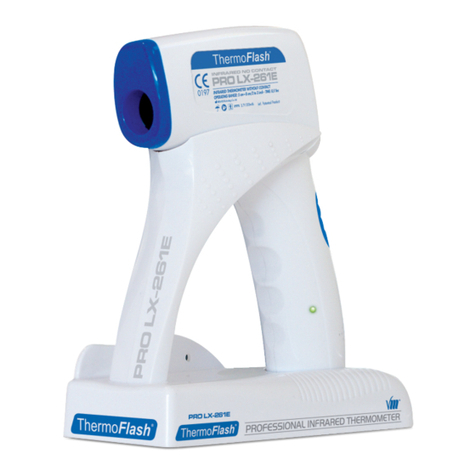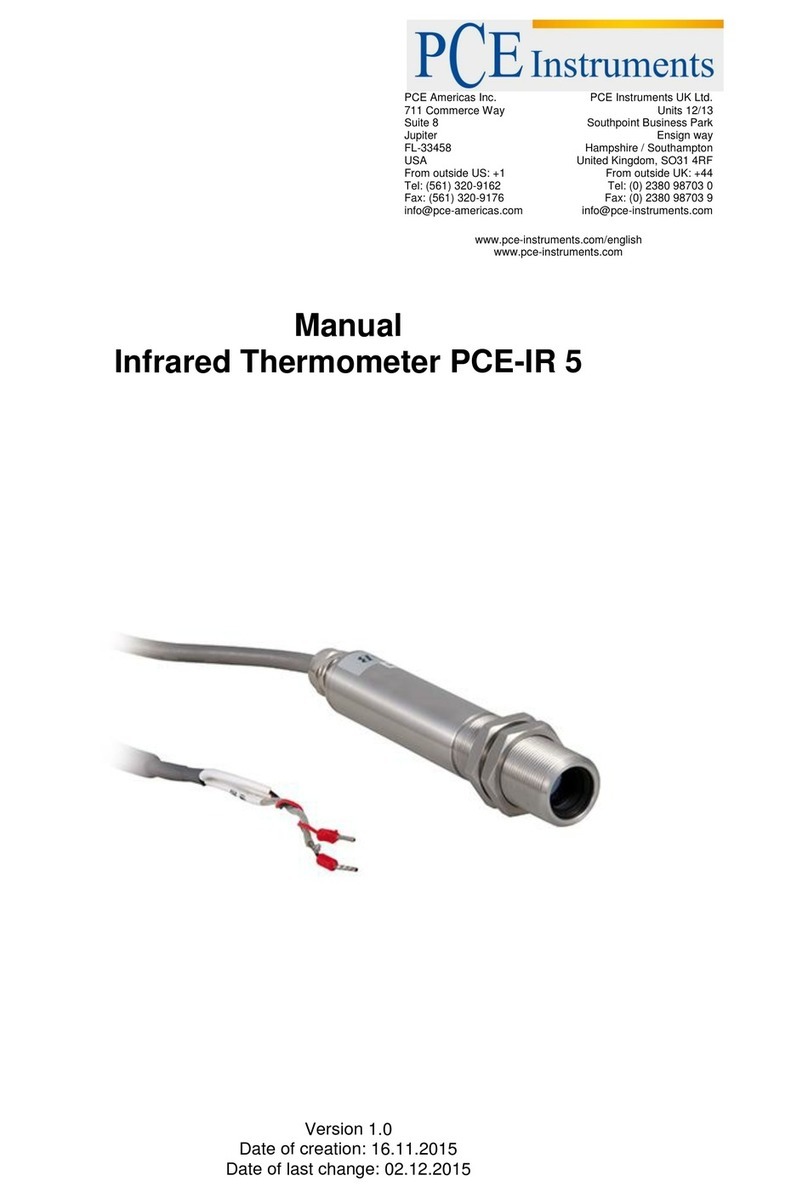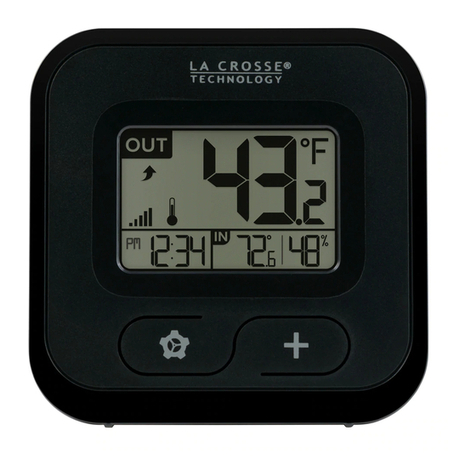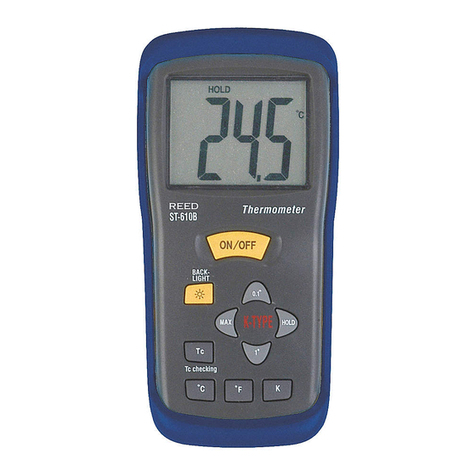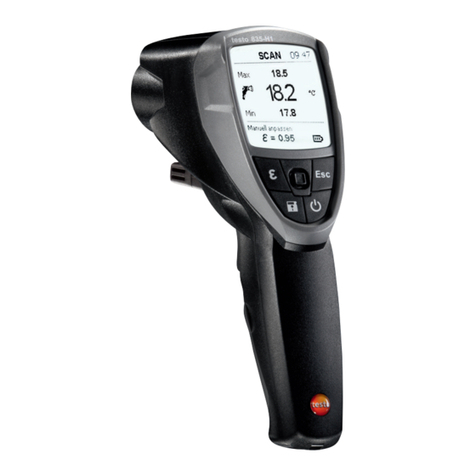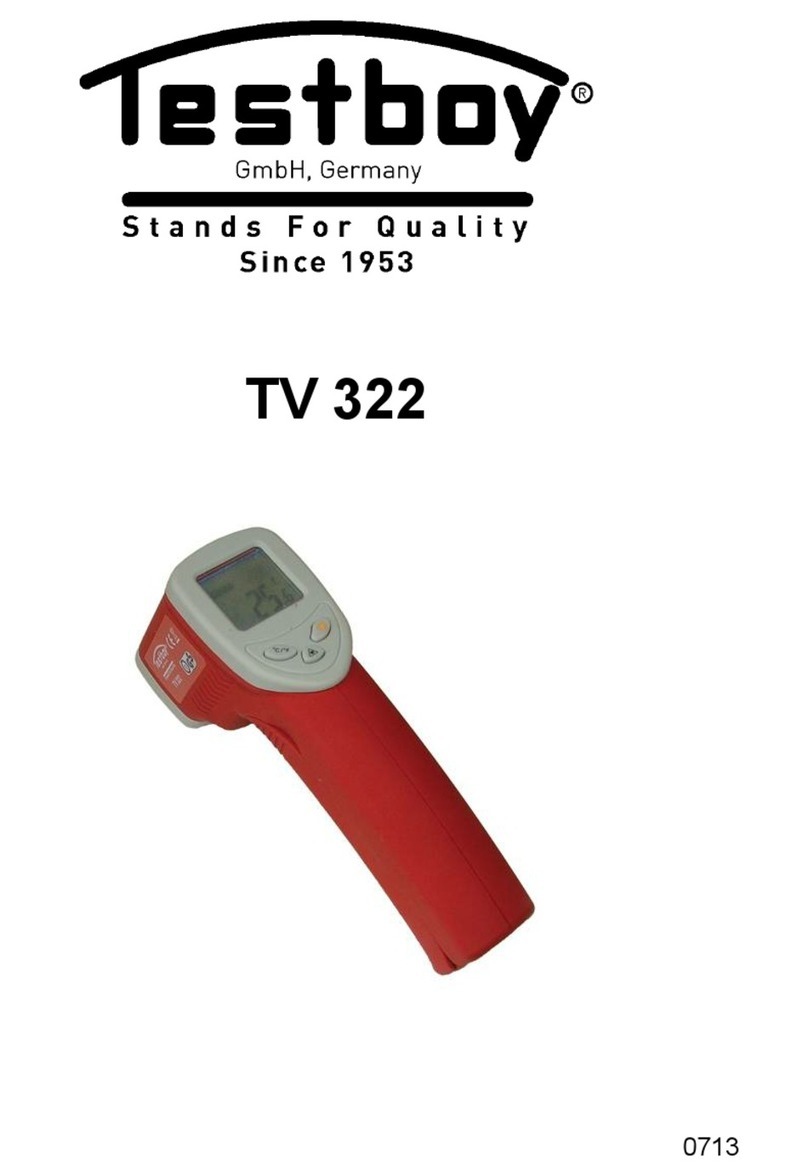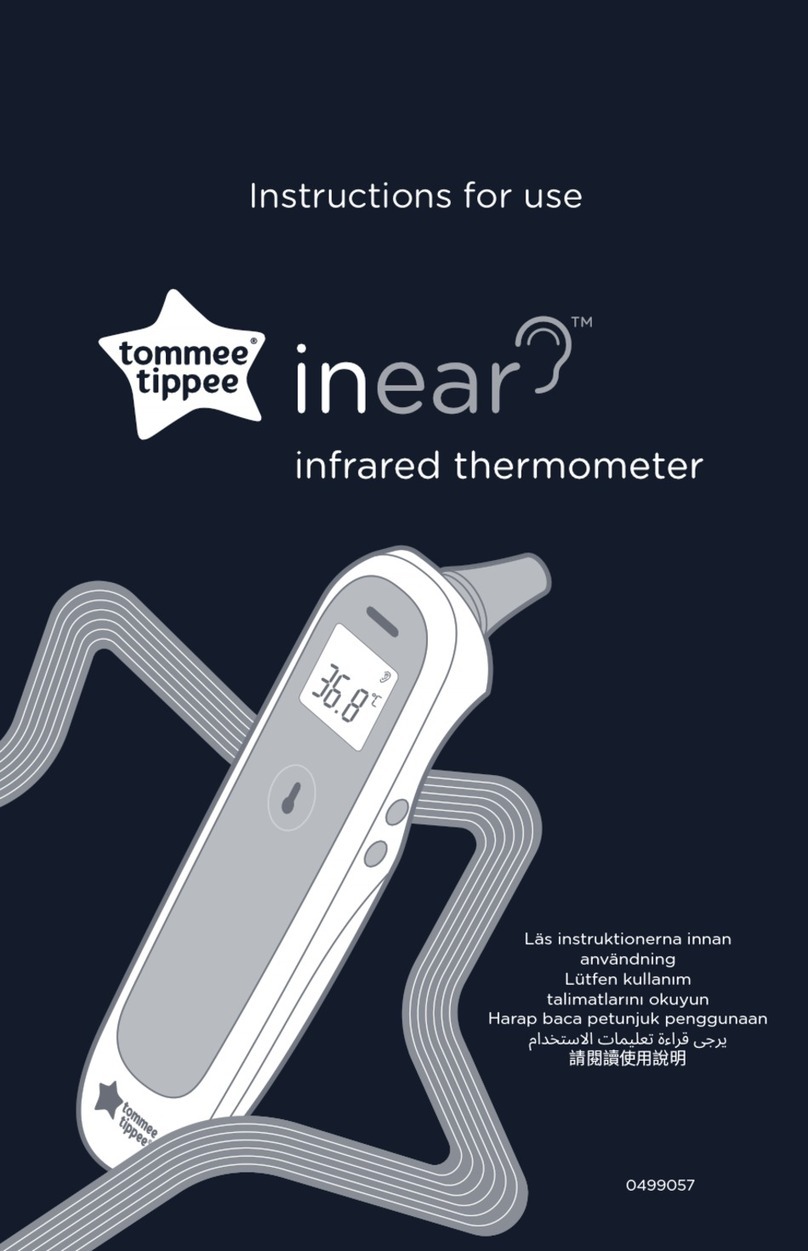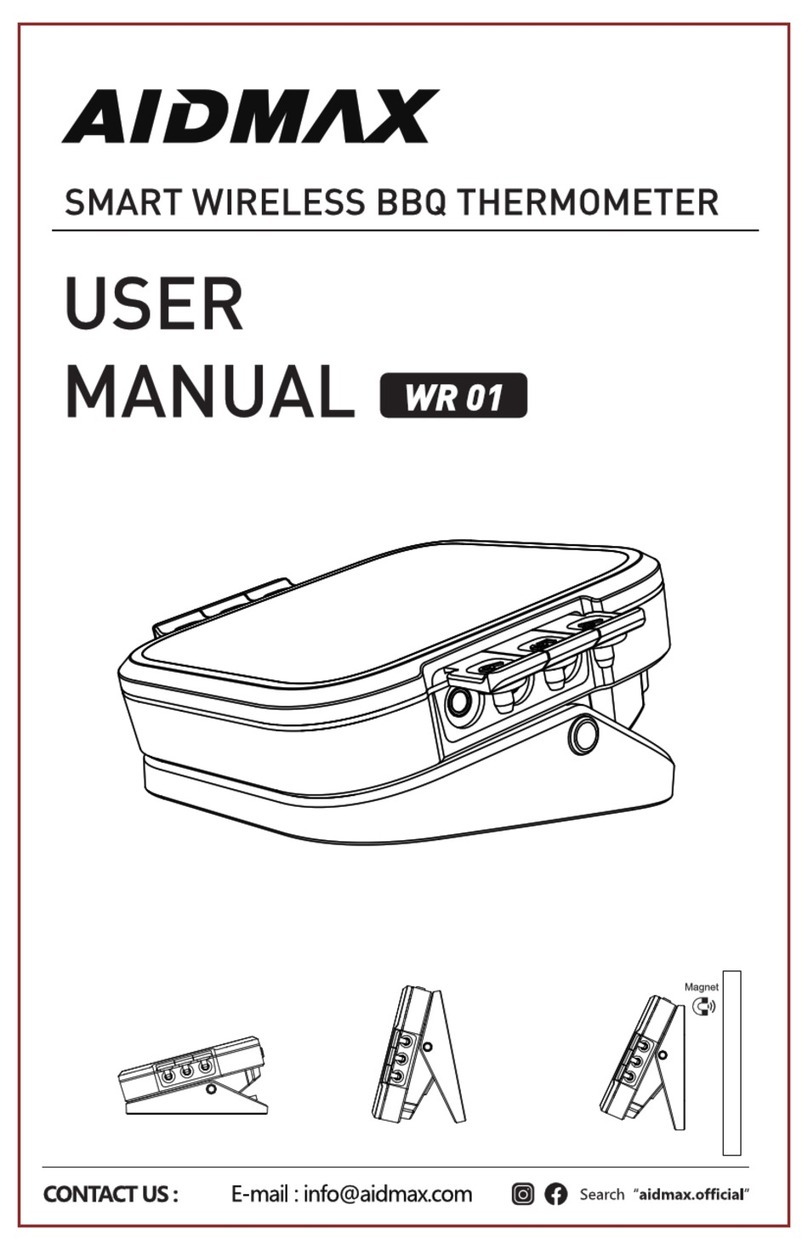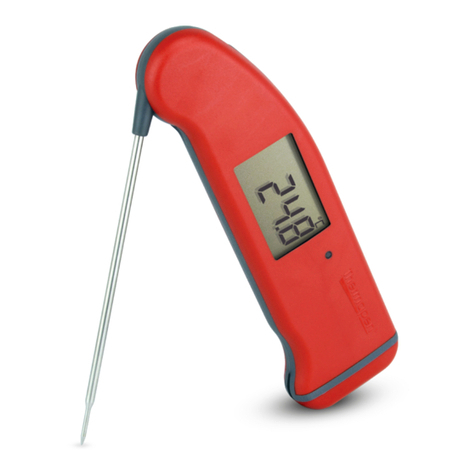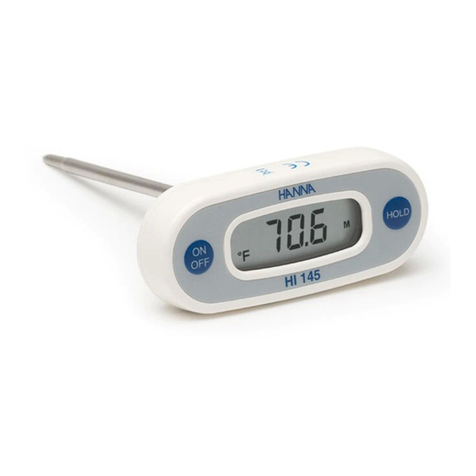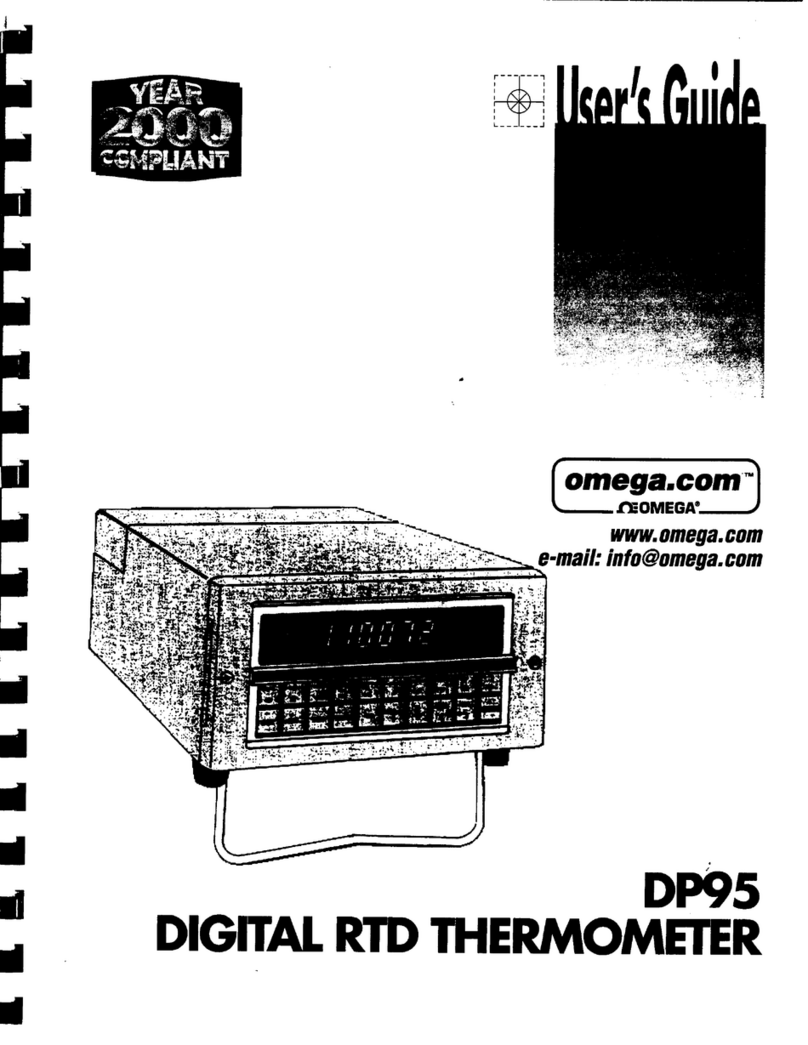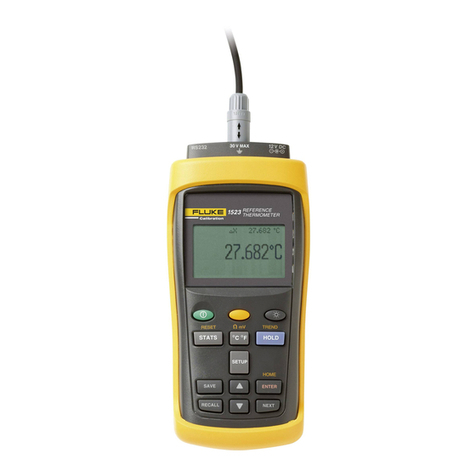VISIOMED THERMOSOFT VM-DS400 User manual

THERMOSOFT VM-DS400 - VM-DS200 - DIGITAL THERMOMETER USER MANUAL
贴纸尺寸:23.6mm x 9.8mm
1.5
Digital Thermometer - Visiomed®
Made in China Battery:SR41(LR41)
IP65
VISOMED TechnologyCo Ltd
., .
SPEC. TYPE:
MODEL AFFECTED: VM-DS200_RATINGLABEL_122016
TO ATTN.
PREP. BY APPROVED. BY
SPEC. NO.
DATE
MODIFY
0
1
2
3
4
02/12/2016
:20170215
贴纸尺寸:23.6mm
x10.9mm
IP65
Digital Thermometer - Visiomed®
VISIOMED TechnologyCo, Ltd.
Made in China - Battery: SR41(LR41)
I/P: 1.5
LOT:
SPEC. TYPE:
MODEL AFFECTED: VM-DS400_RATINGLABEL_022017
TO ATTN.
PREP. BY APPROVED. BY
SPEC. NO. DATE
17/02/17
MODIFY
0
1
2
3
4
1Sonde flexible de mesure / Flexible measurement probe / Flexibler Messfühler / Flexibele meetsonde / Sondadi misur a
flessibile / Punta flexible de medición / Sonda de medição flexível / Elastyczna sonda pomiarowa / / Ölçüm
sondası
2Écran / Screen / Anzeige / Scherm / Display / Pantalla / Ecrã / Ekran / / Ekran
3Touche On/Off / On/Off Switch / Ein/Aus–Taste/Aan/Uit-schakelaar / Tasto On/Off / Interruptor On/Off / Tecla On/Off /
Przycisk On/Off / / / Açma / Kapama dü mesi
4Compartiment à pile / Battery compartment / Batterienfach / Batterijvak / Scomparto pile / Compartimento bacteria /
Compartimento de pilhas / Zamkni cie bateri / / Pil yuvası
Températures normales relevées sur différentes parties du corps / Normal temperatures measured on different parts of the
body / Normaltemperaturen, an verschiedenen Körperpartien gemessen / Normale temperaturen gemeten op diverse
lichaamsdelen / Temperature normali rilevate su diverse parti del corpo / Temperaturas normales medidas en diferentes
partes del cuerpo / Normalne temperatury mierzone na ró nych cz ciach ciała / /
Vücudun farklı bölgelerinde kaydedilen Normal sıcaklıklar
Auriculaire / Auricular / Aurikular / Oor / Auricolare / Oído / Ucho / Auriküler 35.8 - 37.6°C
95 - 98.6°F
Orale / Oral / Oraal / Usta 35.5 - 37.8°C
95 - 98.6°F
Axillaire / Axillary / Axillar / Oksel / Ascellare / Axila / Axilar / Pacha / Aksiller 34.8 - 37.4°C
93,2 - 98.6°F
Rectale / Rectal / Rektal / Rectaal / Rettale / Retal / Odbyt / Rektal 36.4 - 38.2°C
96,8 - 100,4°F
Source: American Academy of Pediatrics
FR
USAGE PRÉVU : Ce produit est exclusivement destiné à mesurer la température du corps humain ; il convient aux
nourrissons, aux enfants et aux adultes. Il peut être utilisé à la maison ou en milieu clinique, afin d’aider à poser un
diagnostic. La température peut être mesurée au niveau de l’aisselle, dans la bouche ou dans le rectum.
Conseil : la prise de température dans le rectum est la méthode s’approchant le plus de la véritable température corporelle.
Prendre la température dans la bouche ou au niveau de l’aisselle nécessite plus de temps et présente l’inconvénient de
fréquemment sous-estimer la température.
AVERTISSEMENTS ET PRÉCAUTIONS DE SÉCURITÉ
- Tenir le thermomètre hors de portée des enfants, afin d’empêcher qu’ils jouent avec ce produit, qu’ils l’avalent ou le mangent.
- Ne pas cogner le thermomètre et ne pas le laisser tomber.
- Ce produit est 100% étanche ; cependant, il n’est pas recommandé de l’immerger dans l’eau ou dans tout autre liquide.
- Ne pas exposer le thermomètre à la lumière directe du soleil, à une température ou une humidité élevée, ni à des conditions
environnementales extrêmes : ceci pourrait affecter son bon fonctionnement.
- Cesser d’utiliser le thermomètre en cas d’anomalie ou de dysfonctionnement.
- Ne pas ouvrir le boîtier du thermomètre, sauf pour remplacer les piles.
- Ne pas mettre le thermomètre en contact avec une peau malade, ulcérée ou meurtrie.
- La prise de température au niveau du rectum peut provoquer des blessures internes. En général, les saignements au niveau
du rectum, les hémorroïdes et les opérations chirurgicales récentes dans le bas de l’intestin accentuent les risques de
blessures.
- S’assurer que le bébé ou le patient n’a pas pris de bain ou n’a pas été langé (pour les bébés) au cours des 20 dernières
minutes. Cela pourrait produire un résultat inexact.
- Ne pas boire de boissons chaudes ou froides, et ne pas faire d’exercice intensif pendant la prise de température.
- Ce DISPOSITIF MÉDICAL ÉLECTRIQUE nécessite des précautions spéciales en ce qui concerne la compatibilité
électromagnétique. Il doit être installé et mis en service conformément aux informations électromagnétiques fournies dans
le tableau EMC DATA.
- Les appareils de radiocommunication portables ou mobiles peuvent affecter les DISPOSITIFS MÉDICAUX ÉLECTRIQUES.
- N’utiliser que les piles recommandées ; ne pas les jeter au feu.
- Les résultats de mesure de ce produit ne sont donnés qu’à titre de référence. En cas de doute, veuillez contacter votre
médecin.
- Ne pas modifier ce dispositif sans autorisation du fabricant.
- Ne pas stocker ou utiliser ce dispositif en dehors des conditions environnementales prescrites ; sinon, il pourrait ne pas
fonctionner correctement et ses performances pourraient s’en trouver affectées.
- Cesser d’utiliser le thermomètre si l’écran LCD affiche « E ». Cela indique que le circuit du capteur a détecté une erreur (comme
une coupure de circuit ou un court-circuit).
- La température d’alarme par défaut est de 37,5°C (99,5°F) ; l’alarme sonore émet alors « Di Di Di Di... ».
- La plage de mesure de ce thermomètre va de 32 à 44 °C (89,6 à 111,2°F). Si la température de test est inférieure à 32°C (89,6°F),
l’écran LCD affiche « L ». Si la température de test est supérieure à 44°C (111,2°F), l’écran LCD affiche « H » ; l’alarme retentit.
INSTRUCTIONS AVANT UTILISATION
Nettoyer l'embout du thermomètre rectal avec de l’eau savonneuse ou de l’alcool à 70 degrés. Pour des raisons d'hygiène ne
jamais se servir du thermomètre pour une prise de mesure sur une autre partie du corps après une utilisation en mode rectal.
INSTRUCTIONS D’UTILISATION
- Pour allumer le thermomètre, appuyer sur la touche On/Off. L’appareil émet un signal sonore. Les symboles de fonction
s’affichent à l’écran pendant quelques secondes. Le résultat de la dernière prise de température s’affiche durant deux
secondes, puis « 36,5°C/97,7°F », puis l’icône « °C » ou « °F » apparaît dans le coin supérieur droit de l’écran. Le thermomètre
est prêt à l’emploi.
Comment prendre la température ?
• Prendre la température au niveau du rectum
Cette méthode est la plus fiable pour s’assurer que la fièvre ne passe pas inaperçue.
Si nécessaire lubrifier l'embout du thermomètre avec un peu de vaseline. Placer l’enfant sur le ventre sur vos genoux ou sur
une surface stable. Sinon, placer l’enfant sur le dos avec les jambes repliées vers sa poitrine. Insérer délicatement le bout du
thermomètre à une profondeur d’environ 1,25 cm. Ne jamais forcer pour introduire le thermomètre dans le rectum. S’arrêter
en cas de résistance. Maintenir le thermomètre ainsi jusqu’à ce qu’il émette un bip.
Retirer le thermomètre avec précaution. Lire la température et la noter. La température prise au niveau du rectum est
généralement plus élevée d’un demi-degré Celsius ou d’un degré Fahrenheit que la température prise dans la bouche. En
retirant le thermomètre, s’assurer que l’embout jetable n’est pas resté dans le rectum du patient, si un embout a été utilisé.
• Prendre la température dans la bouche
La méthode orale n’est pas recommandée pour les enfants de moins de 5 ans, car ils éprouvent des difficultés à garder le
thermomètre sous la langue assez longtemps.
Placer le bout du thermomètre sous la langue aussi loin que possible. Serrer les lèvres doucement autour du thermomètre. Ne
pas mordre le thermomètre. Se détendre et respirer par le nez. Garder le thermomètre sous la langue jusqu’à ce qu’il émette
un bip.
Attendre 20 à 30 minutes après avoir mangé ou bu pour prendre la température dans la bouche.
• Prendre la température au niveau de l’aisselle
Important : la méthode axillaire (au niveau de l’aisselle) est généralement utilisée pour vérifier si un nouveau-né ou un jeune
enfant a de la fièvre, mais elle n’est pas aussi précise que la méthode rectale. Si la température axillaire ne révèle pas de fièvre
mais que l’enfant est chaud et semble souffrant, prendre la température dans le rectum.
Essuyer l’aisselle avec une serviette sèche.
Placer le bout du thermomètre au niveau de l’aisselle.Veiller à ce que le thermomètre soit en contact avec la peau et non avec
les vêtements. Presser le bras contre le corps pour maintenir le thermomètre en place. Garder la position jusqu’à ce que le
thermomètre émette un bip.
Si les températures affichées par deux thermomètres devaient être comparées, il est possible d’obtenir deux résultats
différents alors même que les deux thermomètres se situent dans leur marge de précision.
Nettoyer soigneusement le thermomètre avant de le ranger. Le sécher et le ranger dans sa boîte pour qu’il soit prêt à
l’utilisation la prochaine fois.
- Lors de la prise de mesure, la température affichée à l’écran change. Le symbole « °C » ou « °F » clignote. Lorsque le signal
sonore retentit 4 fois, cela signifie que la température a atteint un niveau stable et que la prise de température est terminée,
la mesure est affichée à l’écran pendant 10 minutes jusqu’à l’arrêt automatique de l’appareil. Appuyer sur la touche On/Off
pour l’arrêter manuellement.
- Quand la tension de la pile est de 1,25 V ± 0,06 V et que l’écran LCD affiche le symbole“ ”, cela signifie que la pile doit être
remplacée.
- Retirer d’abord le capot de pile, tirer la partie interne de 3 à 5 mm (pas plus de 10 mm), insérer la pile LR41 neuve, avec le
positif au-dessus, et vérifier que la pile est bien clipsée. Ensuite, refermer le capot, remettre en marche et tester.
- °C/°F : appareil éteint, appuyer sur la touche On/Off pendant 3 secondes ; il est alors possible de basculer entre °C et °F.
- MÉMORISATION DES DONNÉES : l’appareil conserve automatiquement la dernière température en mémoire pour évaluation
des variations éventuelles. En allumant l’appareil, la dernière mesure s’affiche après le test d’initialisation.
UK
INTENDED USE: The product is exclusively meant to be used for human body temperature measuring, suitable for all
age infants, children and adults. It can be used for households, and for medical purposes, providing the reference for
clinical diagnosis. Measuring areas of body can be axillary, oral or rectum.
Advice : A temperature taken in the rectum is the closest way to finding the body’s true temperature.
Axillary and oral temperature measurements need over long time periods and have a disadvantage to frequently
underestimate measures.
SAFETY & WARNING PRECAUTION
- Please keep the thermometer off the children touch. Prevent the product from children playing, swallowing and eating.
- Do not shock the thermometer or let it fall down.
- The product is 100% waterproof, it is not recommended to immerse it in water or other liquids.
- Do not expose the thermometer to direct sunlight, high temperature/humidity or any extreme environment, or the function
will be reduced.
- Stop using the thermometer when it’s abnormal or malfunctions.
- Do not open the thermometer case unless replacing the batteries.
- Do not put the thermometer in contact with diseased, ulcer or bruise skin.
- Taking rectal temperatures can cause internal injury. In general, bleeding from rectum, hemorrhoids, and recent lower
intestinal surgery would place the person at higher risk for further injury.
- Be sure that the baby or patient has not had a bath or been swaddled (when babies are wrapped tightly for warmth) in the
past 20 minutes. This can cause an inaccurate reading.
- Do not drink cold/hot beverages or exercise violently when measuring the temperature.
- This MEDICAL ELECTRICAL EQUIPMENT needs special precautions regarding EMC and needs to be installed and put into
service according to the EMC DATA table.
- Portable and mobile RF communications equipment can affect MEDICAL ELECTRICAL EQUIPMENT.
- Only use the recommended batteries, do not burn them.
- The measuring result of this product is only for your reference. If you have any doubt, please contact your doctor.
- Do not modify this equipment without authorization of the manufacturer.
- Do not store or operate the device outside prescribed environmental conditions, as running performance of the device
might be affected or the device might not work properly.
- Stop using the thermometer if the LCD displays the“E”, it indicates the sensor circuit detecting an error (such as open or short
circuit).
- The default alarm temperature is 37.5°C (99.5°F), the alarm sound is ”Di Di Di Di...”.
- The measuring range of this thermometer is 32 - 44°C (89.6 - 111.2°F). If the test temperature is < 32°C (89.6°F), LCD display
“L”; if the test temperature > 44°C (111.2°F), LCD display“H”, the buzzer will alarm.
INSTRUCTIONS BEFORE USE
Clean the tip of the rectal thermometer with soapy water or rubbing alcohol. For hygiene reasons, if the thermometer is ever
used in rectal mode it should never again be used for measurement of another part of the body.
OPERATING INSTRUCTIONS
- To switch on the thermometer, press the On/Off button. The appliance emits a beep.The function symbols are displayed on
the screen for a few seconds. The result of the last temperature measurement is displayed for two seconds, then
“36.5°C/97.7°F”and “°C”or “°F”icons appear in the top right hand corner of the screen. The thermometer is then ready to use.
How do I take a temperature?
• To take a rectal temperature
This is the most reliable way to ensure a fever is not missed.
If necessary lubricate the tip of the thermometer with a small amount of petroleum jelly. Place your child face down across
your lap or on a firm surface. Or, place your child face up with legs bent toward his or her chest. Gently insert the tip of the
thermometer about ½ inch (1.25 cm). Never force the thermometer into the rectum. Stop if you feel any resistance. Hold it
there until it beeps.
Remove the thermometer carefully. Read the temperature and record it.Temperatures taken rectally usually read as 1 degree
F (0.5 degree C) higher than temperatures taken orally. As you remove the thermometer, be sure the disposable sleeve is
removed from the patient’s rectum, if you used one on the thermometer.
• To take an oral temperature
The oral method is not recommended for children younger than 5 years old because it is hard for them to hold the
thermometer under their tongue for long enough.
Put the tip under your tongue as far as it can go. Close your lips gently around the thermometer. Do not bite the thermometer.
Relax and breathe through your nose. Keep the thermometer under your tongue until it beeps.
Wait 20 to 30 minutes after you or your child finish eating or drinking to take an oral temperature.
• To take an underarm temperature
Important : The armpit (axillary) method is usually used to check for fever in newborns and young children, but it is not as
accurate as a rectal temperature. If an axillary temperature does not show a fever but your child feels warm and seems unwell,
take a rectal measurement.
Wipe armpit with a dry towel.
Put the tip in your or your child’s armpit. Make sure the thermometer is touching skin and not clothes. Squeeze your arm
against your body to hold the thermometer in place. Keep the thermometer in your armpit until it beeps.
If you compare temperatures between two thermometers, it is possible to have two different readings, even if both
thermometers are within their accuracy tolerances.
Clean the thermometer thoroughly before storing it. Dry it and store it in its packaging so it is ready to use next time.
- When taking a measurement, the temperature displayed on the screen changes.The symbol“°C” or“°F” symbol flashes.When
the beep sounds 4 times, this means that the temperature has reached a stable level and that the temperature measurement
is complete. The measurement is then displayed on the screen for 10 minutes until the appliance is switched off
automatically. Press the On/Off button to stop the appliance manually.
- When the battery voltage is 1,25V ± 0,06V, and the LCD display the symbol of“ ”, it means you have to replace the battery.
- Remove the battery cover first, pull out the inner part 3-5mm (no more than 10mm), put into the new LR41 battery, keep
positive above and make sure the battery well snap into the buckle, then close the battery cover, re-boot, and test.
- °C/°F : Under the shutdown status, press the On/Off button 3s, you can switch between °C and °F.
- MEMORISING THE DATA : The appliance automatically stores the last temperature in memory so that any variations may be
evaluated. When the appliance is switched on, the last measurement is displayed after the initialization test.
DE
VERWENDUNGSZWECK DES GERÄTS: Das Gerät ist ausschließlich zur Messung der menschlichen Körpertemperatur
bestimmt und für Kleinkinder und Kinder jeden Alters sowie für Erwachsene geeignet. Es kann im Haushalt und in
medizinischen Einrichtungen verwendet werden und als Grundlage für ärztliche Diagnosen dienen. Die Messungen können
im Achsel-, Oral- und Rektalbereich vorgenommen werden.
Hinweis: Die im Rektalbereich gemessene Temperatur kommt der tatsächlichen Körpertemperatur am nächsten.
Messen Sie zunächst (hilfsweise) die Temperatur des Kindes oder Patienten unter der Achsel, wenn es mit der rektalen
Messung nicht einverstanden ist. Hierfür können Sie jedes beliebige orale Digitalthermometer verwenden.
Temperaturmessungen im Achsel- und Oralbereich dauern lange und haben den Nachteil, dass die Messergebnisse oft
unterschätzt werden.
SICHERHEITS- UND WARNHINWEISE
- Bitte bewahren Sie das Thermometer für Kinder unzugänglich auf. Achten Sie darauf, dass Kinder mit dem Gerät nicht
spielen, es verschlucken oder essen können.
- Setzen Sie das Thermometer keinen Stößen aus und lassen Sie es nicht fallen.
- Das Gerät ist zu 100 % wasserfest, dennoch wird davon abgeraten, es in Wasser oder andere Flüssigkeiten zu tauchen.
- Setzen Sie das Thermometer keiner direkten Sonneneinstrahlung, hoher Temperatur/Feuchtigkeit oder anderen extremen
Bedingungen aus, da hierdurch seine Funktionsfähigkeit beeinträchtigt wird.
- Benutzen Sie das Thermometer im Fall eines Fehlers oder einer Funktionsstörung nicht weiter.
- Öffnen Sie das Thermometer ausschließlich zum Wechseln der Batterien.
- Bringen Sie das Thermometer nicht mitWunden, Geschwüren oder Blutergüssen auf der Haut in Kontakt.
- Eine rektale Temperaturmessung kann zu inneren Verletzungen führen. Im Allgemeinen besteht bei Personen mit Blutungen
im Rektalbereich, mit Hämorrhoiden und kürzlich durchgeführter Darmoperation ein höheres Verletzungsrisiko.
- Stellen Sie sicher, dass das Baby oder der Patient in den zurückliegenden 20 Minuten kein Bad hatten oder in Tücher
gewickelt waren (enges Wickeln der Babys, um sie zu wärmen). Dies kann zu verfälschten Messergebnissen führen.
- Trinken Sie während der Messung keine heißen/kalten Getränke und vermeiden Sie körperliche Anstrengungen.
- Dieses MEDIZINISCHE ELEKTRISCHE GERÄT bedarf besonderer Vorsichtsmaßnahmen hinsichtlich der EMV und muss gemäß
der EMV-DATEN-Tabelle aufgestellt und in Betrieb genommen werden.
- Tragbare und mobile HF-Kommunikationsgeräte können die Funktion MEDIZINISCHER ELEKTRISCHER GERÄTE
beeinträchtigen.
- Verwenden Sie nur empfohlene Batteriearten; diese nicht in offenes Feuer werfen.
- Das Messergebnis dieses Geräts stellt lediglich einen Anhaltspunkt für Sie dar. Bei Zweifeln wenden Sie sich bitte an Ihren
Arzt.
- Bauen Sie das Gerät ohne die Erlaubnis des Herstellers nicht um.
- Lagern und verwenden Sie das Gerät nicht außerhalb der beschriebenen Umgebungsbedingungen, da die
Leistungsfähigkeit oder das ordentliche Funktionieren des Geräts beeinträchtigt werden könnten.
- Verwenden Sie das Gerät nicht weiter, wenn das LCD„E“ anzeigt; dies bedeutet, dass im Sensor-Kreislauf ein Fehler vorliegt
(etwa eine Unterbrechung oder ein Kurzschluss).
- Der Standard-Temperaturalarm liegt bei 37,5 °C (99,5°F), das Alarmsignal ist„Di Di Di Di ...“.
- Der Messbereich des Thermometers liegt bei 32 - 44°C (89,6 – 111,2°F). Wenn die Testtemperatur mehr als < 32°C (89,6°F)
beträgt, zeigt das LCD„L“ an; wenn die Testtemperatur > 44°C (111,2°F) beträgt, zeigt das LCD„H“ an, und der Alarm ertönt.
HINWEISE VOR DEM GEBRAUCH
Reinigen Sie die Spitze des Rektalthermometers mit Wasser und Seife oder mit Reinigungsalkohol. Verwenden Sie das
Thermometer, das Sie im Rektum verwenden, niemals für Messungen an anderen Körperstellen, da sich hierdurch Bakterien
verbreiten könnten.
GEBRAUCHSHINWEISE
- Um das Thermometer anzuschalten, drücken Sie die On/Off-Taste. Das Gerät piepst kurz. Die Funktionssymbole werden für
Einige Sekunden auf dem Display angezeigt. Das Ergebnis der letzten Temperaturmessung wird für zwei Sekunden
angezeigt, dann erscheinen „36,5°C/97,7°F“ und die Symbole „°C“ oder „°F“ in der oberen rechten Ecke des Displays. Das
Thermometer ist nun bereit für den Gebrauch.
Wie messe ich die Temperatur?
• Rektale Temperaturmessung
Dies ist der sicherste Weg, um festzustellen, ob Fieber vorliegt.
Schmieren Sie die Spitze des Thermometers mit ein wenig Vaseline ein. Legen Sie Ihr Kind mit dem Gesicht nach unten auf
Ihren Schoß oder auf eine stabile Unterlage. Oder legen Sie Ihr Kind mit dem Gesicht nach oben hin, die Beine auf die Brust
gedrückt. Schieben Sie die Spitze des Thermometers vorsichtig ½ Inch (1,25 cm) in das Rektum. Führen Sie das Thermometer
niemals mit Gewalt in das Rektum ein. Halten Sie an, wenn Sie einen Widerstand spüren. Halten Sie es an dieser Stelle bis zum
Piepsen.
• Orale Temperaturmessung
Die orale Methode wird für Kinder unter 5 Jahren nicht empfohlen, weil es nicht einfach für sie ist, das Thermometer lang
genug unter ihrer Zunge zu halten.
Stecken Sie die Spitze so weit wie möglich unter die Zunge. Legen Sie die Lippen sanft um dasThermometer. Beißen Sie nicht
in das Thermometer. Entspannen Sie sich und atmen Sie durch die Nase. Lassen Sie das Thermometer so lange unter Ihrer
Zunge, bis es piepst.
Warten Sie nach dem Essen oder Trinken20 oder 30 Minuten, ehe Sie bei sich oder Ihrem Kind die Temperatur oral messen.
• Temperaturmessung unter der Achsel
Wichtig: Die Achsel-Methode wird normalerweise für Fiebermessungen bei Neugeborenen und Säuglingen verwendet, sie ist
jedoch nicht so exakt wie die rektale Messung. Wenn die Achselmessung kein Fieber anzeigt, sich Ihr Kind jedoch heiß anfühlt
und es unwohl zu sein scheint, dann führen Sie eine rektale Messung durch.
Wischen Sie die Achsel mit einem trocknen Handtuch ab. Platzieren Sie das Gerät in der Achsel; nun drückt der Patient seinen
Arm fest gegen seinen Oberkörper.
Legen Sie die Thermometerspitze in Ihre Achsel oder die Ihres Kindes. Stellen Sie sicher, dass das Thermometer die Haut
berührt und keine Kleidung. Drücken Sie Ihren Arm gegen Ihren Oberkörper, um das Thermometer festzuhalten. Halten Sie
das Thermometer in Ihrer Achsel, bis es piepst.
Ziehen Sie das Thermometer in jedem Fall vorsichtig zurück, wenn es piepst oder ein Signal sendet. Lesen Sie die Temperatur
ab und speichern Sie sie. Rektal gemessene Temperaturen liegen normalerweise um 1 Grad F (0,5 Grad C) über den oral
gemessenen Temperaturen. Wenn Sie dasThermometer zurückziehen, stellen Sie sicher, dass der Einwegüberzug nicht noch
im Rektum des Patienten steckt, sofern Sie einen solchen für dasThermometer verwendet haben.
Wenn Sie die Temperaturen zweier Thermometer vergleichen, ist es möglich, dass Sie zwei unterschiedliche Ergebnisse
feststellen, auch wenn beide Thermometer innerhalb ihrer Messtoleranzen liegen.
Reinigen Sie das Thermometer vor dem Aufräumen sorgfältig. Verwenden Sie Wasser und Seife oder Reinigungsalkohol zur
Reinigung des Thermometers.Trocknen Sie es ab und heben Sie es in seinerVerpackung auf, sodass es immer einsatzbereit ist.
- Während der Messung ändert sich die auf dem Display angezeigte Temperatur. Das Symbol„°C“ oder„°F“ blinkt auf. Wenn ein
4-maliges Piepsen zu hören ist, bedeutet dies, dass die Temperatur einen stabilen Wert erreicht hat und die
Temperaturmessung abgeschlossen ist. Die Messung wird nun für 10 Minuten auf dem Display angezeigt, ehe es sich
automatisch ausschaltet. Drücken Sie die On/Off-Taste, um die Anzeige manuell zu beenden.
- Wenn die Stromstärke der Batterie 1,25V ± 0,06 V beträgt und das LCD das Symbol„ “ anzeigt, bedeutet dies, dass Sie die
Batterie auswechseln müssen.
- Nehmen Sie zuerst die Abdeckung des Batteriefachs ab, Ziehen Sie das Innere 3-5 mm (niemals mehr als 10 mm) heraus,
legen Sie eine neue LR41 Batterie ein, mit dem Pluspol nach oben, stellen Sie sicher, dass die Batterie fest in der Schnalle sitzt;
dann schließen Sie die Abdeckung des Batteriefachs, starten das Gerät neu und testen es.
- °C/°F: Drücken Sie bei ausgeschaltetem Gerät 3 Sekunden lang die On/Off-Taste; nun können Sie zwischen °C und °F wählen.
- DATEN SPEICHERN: Das Gerät speichert die letzte Temperaturmessung automatisch, sodass alle Veränderungen analysiert
werden können. Beim Einschalten des Geräts wird nach dem Eingangstest die letzte Messung angezeigt.
NL
BEDOELD GEBRUIK: Het product is uitsluitend bestemd om te worden gebruikt voor het meten van de menselijke
lichaamstemperatuur en is geschikt voor alle leeftijdsgroepen: baby’s, kinderen en volwassenen. Het kan gebruikt
worden door gezinnen en voor medische doeleinden, als referentie voor de klinische diagnose. De mogelijke meetgebieden
van het lichaam zijn: oksel, mond of rectum.
Advies: Een temperatuur die gemeten wordt in het rectum is de beste manier om de ware lichaamstemperatuur te kennen.
Neem eerst de temperatuur van de oksel van uw kind of van de patiënt als hij of zij lijkt te protesteren tegen de rectale
methode. U kunt hiervoor om het even welke orale digitale thermometer gebruiken.
De oksel- en orale temperatuurmetingen moeten over een lange tijdsperiode worden gemeten en hebben een nadeel de
metingen vaak te onderschatten.
VEILIGHEIDSVOORSCHRIFTEN & WAARSCHUWINGEN
- Houd de thermometer buiten het bereik van kinderen. Voorkom dat kinderen met het product spelen, het inslikken of
opeten.
- Onderwerp de thermometer niet aan schokken en laat hem niet vallen.
- Het product is 100% waterdicht maar er wordt aanbevolen om het niet in water of andere vloeistoffen onder te dompelen.
- Stel de thermometer niet bloot aan direct zonlicht, hoge temperaturen/luchtvochtigheid of een extreme omgeving, of de
werking ervan zal worden verminderd.
- Stop met het gebruik van de thermometer wanneer het abnormaal werkt of wanneer er storingen zijn.
- Laat de behuizing van de thermometer dicht, tenzij u de batterijen moet vervangen.
- Plaats de thermometer niet in contact met een zieke huid, zweren of blauwe plekken.
- Het meten van de rectale temperatuur kan inwendige letsels veroorzaken. In het algemeen vormen bloeden uit het rectum,
aambeien, en recente lagere intestinale chirurgie een hoger risico op verdere letsels voor de persoon.
- Zorg ervoor dat de baby of de patiënt geen bad heeft genomen of ingewikkeld is (wanneer baby’s stevig worden ingepakt
voor warmte) in de laatste 20 minuten. Dit kan onnauwkeurige metingen veroorzaken.
- Drink geen koude/warme dranken en maak geen geweldige bewegingen tijdens het meten van de temperatuur.
- Deze medische elektrische apparatuur vereist speciale voorzorgsmaatregelen ten aanzien van EMC en moet worden
geïnstalleerd en in bedrijf worden gesteld volgens de EMC-DATA tabel.
- Draagbare en mobiele RF-communicatieapparatuur kan medische elektrische apparatuur beïnvloeden.
- Gebruik alleen de aanbevolen batterijen, en verbrand ze niet.
- Het meetresultaat van dit product is alleen voor uw referentie. Als u twijfelt, neem dan contact op met uw arts.
- Breng geen wijzigingen aan deze apparatuur aan zonder toestemming van de fabrikant.
- Bewaar of bedien het apparaat niet buiten voorgeschreven omgevingsvoorwaarden, omdat de werking van het apparaat
kan worden beïnvloed of het apparaat mogelijk niet goed zal werken.
- Stop met het gebruik van de thermometer als het LCD-scherm de “E”weergeeft. Dit toont aan dat de sensorschakeling een
fout detecteert (zoals open circuit of kortsluiting).
- De standaard alarmtemperatuur bedraagt 37,5°C (99,5°F), het alarmgeluid gaat als volgt:“Di Di Di Di...”.
- Het meetbereik van de thermometer is 32 - 44°C (89,6 - 111,2°F). Als de testtemperatuur onder < 32°C (89,6°F) is met“L” op
het LCD-scherm; als de testtemperatuur > 44°C (111,2°F) is met“H”op het LCD-scherm, dal zal de zoemer afgaan.
INSTRUCTIES VOOR GEBRUIK
Reinig de punt van de rectale thermometer met zeepwater of schoonmaakalcohol. Gebruik nooit dezelfde thermometer die
u gebruikt in de rectum om temperaturen op andere manieren te meten, omdat dit bacterieën kan verspreiden.
GEBRUIKSAANWIJZINGEN
- Druk op de aan/uit-knop om de thermometer in te schakelen. Het apparaat geeft een pieptoon. De functiesymbolen
verschijnen op het scherm gedurende enkele seconden. Het resultaat van de laatste temperatuurmeting wordt gedurende
twee seconden weergegeven, daarna verschijnen“36,5°C/97,7°F” en de pictogrammen“°C” of“°F” in de rechter bovenhoek
van het scherm. De thermometer is klaar voor gebruik.
Hoe meet ik een temperatuur?
• Een rectale temperatuur meten
Dit is de meest betrouwbare manier om koorts te detecteren.
Smeer de punt van de thermometer met een kleine hoeveelheid vaseline. Plaats uw kind met het gezicht naar beneden over
uw schoot of op een stevige ondergrond. Of, plaats uw kind met het gezicht naar boven en met de benen gebogen in de
richting van zijn of haar borst. Schuif voorzichtig de punt van de thermometer ongeveer ½ inch (1,25 cm) in het rectum.
Forceer nooit de thermometer in het rectum. Stop als u weerstand voelt. Houd de thermometer daar tot hij piept.
• Een orale temperatuur meten
De orale methode wordt niet aanbevolen voor kinderen jonger dan 5 jaar oud, want het is moeilijk voor hen om de
thermometer lang genoeg onder hun tong te houden.
Plaats de punt zo ver mogelijk onder uw tong. Sluit uw lippen zachtjes rond de thermometer. Bijt niet in de thermometer.
Ontspan en adem door uw neus. Houd de thermometer onder uw tong tot hij piept.
Wacht 20 tot 30 minuten nadat u of uw kind klaar is met eten of drinken om een mondelinge temperatuur op te nemen.
• Een okseltemperatuur meten
Belangrijk: De okselmethode wordt meestal gebruikt om te controleren op koorts bij baby’s en jonge kinderen, maar het is
niet zo nauwkeurig als de rectale temperatuur. Als een okseltemperatuur geen koorts aanduidt maar uw kind toch warm
aanvoelt en onwel lijkt, voer dan een rectale meting uit.
Veeg de oksel af met een droge handdoek. Plaats de sonde in de oksel van de patiënt en houd de arm van de patiënt stevig
tegen hun zijde gedrukt.
Plaats de punt in uw oksel of de oksel van uw kind. Zorg ervoor dat de thermometer de huid raakt en geen kleren. Knijp uw
arm tegen uw lichaam om de thermometer op zijn plaats te houden. Houd de thermometer in uw oksel tot hij piept.
Verwijder de thermometer voorzichtig wanneer de thermometer piept of een signaal afgeeft. Lees de temperatuur en neem
op. Rectaal gemeten temperaturen zijn meestal 1 graad F (0,5 graden C) hoger dan de oraal gemeten temperatuur. Zorg
ervoor, wanneer u de thermometer verwijdert, dat de wegwerphuls uit het rectum van de patiënt is verwijderd, indien u er
een hebt gebruikt op de thermometer.
Als u de temperatuur vergelijkt tussen twee thermometers, is het mogelijk dat u twee verschillende lezingen krijgt, zelfs
wanneer beide thermometers binnen hun nauwkeurigheidslimieten zijn.
Maak de thermometer grondig schoon voordat u hem opbergt. Gebruik zeepwater of schoonmaakalcohol om de
thermometer te reinigen. Droog af en bewaar in de verpakking zodat de thermometer klaar is voor de volgende meting.
- Tijdens een meting verandert de temperatuur op het scherm. Het symbool “°C” of “°F” knippert. Bij 4 pieptonen heeft de
temperatuur een stabiel niveau bereikt en is de temperatuurmeting voltooid. De meting wordt dan weergegeven op het
scherm gedurende 10 minuten tot het apparaat automatisch uitschakelt. Druk op de aan/uit-toets om het apparaat
handmatig te stoppen.
- Wanneer de batterijspanning 1,25V ± 0,06V is, en het LCD-scherm het symbool “ ”betekent dat u de batterij moet
vervangen.
- Verwijder eerst het batterijdeksel, trek het binnendeel 3-5mm (maximaal 10 mm) naar buiten, plaats de nieuwe LR41-batterij
met de positieve kant naar boven en zorg ervoor dat de batterij goed vastklikt in de houder, sluit het deksel, schakel de
thermometer in en test.
- °C/°F: Wanneer de thermometer uitgeschakeld is kunt u 3s op de aan/uit-knop drukken om te schakelen tussen °C en °F.
- GEGEVENS ONTHOUDEN: Het apparaat slaat de laatste temperatuur automatisch op in het geheugen zodat eventuele
variaties kunnen worden gevolgd. Wanneer het apparaat ingeschakeld is, wordt de laatste meting weergegeven na de test.
ES
USO PREVISTO: El producto está diseñado exclusivamente para medir la temperatura corporal en bebés, niños y
adultos de cualquier edad. Se puede utilizar en casa o en ámbito clínico para ayudar a establecer un diagnóstico. La
temperatura puede ser tomada en las axilas, la boca o el recto.
Recomendación: tomar la temperatura en el recto permite acercarse más a la verdadera temperatura corporal.
Primero tomar la temperatura en la axila del niño o del paciente, si este parece rechazar el método rectal. Para esto, puede
utilizar cualquier termómetro digital oral.
Tomar la temperatura en la axila o en la boca necesita más tiempo y, frecuentemente, resulta en temperaturas subestimadas.
SEGURIDAD Y ADVERTENCIAS
- Mantener el termómetro fuera del alcance de los niños para que no jueguen con el producto, se lo traguen o lo coman.
- No golpear el termómetro ni dejarlo caer.
- El producto es 100 % resistente al agua, pero se recomienda no sumergirlo en agua u otros líquidos.
- No exponer el termómetro a la luz solar directa, temperatura o humedad alta ni a condiciones ambientales extremas: esto
podría afectar su buen funcionamiento.
- Dejar de usar el termómetro en caso de funcionamiento anormal.
- Sólo abrir la caja del termómetro para cambiar las pilas.
- No colocar el termómetro en contacto con piel enferma, con úlcera o herida.
- Tomar temperaturas rectales puede causar lesiones internas. En general, el sangrado por el recto, las hemorroides y una
reciente cirugía del intestino delgado aumentan el riesgo de lesiones.
- Asegurarse que el bebé o el paciente no se haya bañado o fajado (para los bebés) en los últimos 20 minutos. Esto puede
causar un resultado inexacto.
- No tomar bebidas frías o calientes ni hacer ejercicios intensos durante la medición de temperatura.
- Este EQUIPO MÉDICO ELÉCTRICO requiere precauciones especiales en relación con la compatibilidad electromagnética y
necesita instalarse y ponerse en servicio de acuerdo con la información en la tabla EMC DATA.
- Los equipos de radiocomunicación portátiles y móviles pueden afectar los EQUIPOS MÉDICOS ELÉCTRICOS.
- Utilizar sólo las pilas recomendadas; no quemarlas.
- El resultado de la medición de este producto es sólo para su referencia. En caso de duda, consultar un médico.
- No modificar este equipo sin la autorización del fabricante.
- No guardar ni utilizar este dispositivo fuera de las condiciones ambientales prescritas; el rendimiento del dispositivo puede
verse afectado o el dispositivo podría no funcionar correctamente.
- Dejar de usar el termómetro si la pantalla LCD muestra la «E». Esto indica que el circuito del sensor ha detectado un error
(como un circuito abierto o cortocircuito).
- La temperatura de alarma por defecto es 37,5 °C (99,5 °F), el sonido de la alarma es «Di Di Di Di…».
- El rango de medición de este termómetro es de 32-44 °C (89,6-111,2 °F). Si la temperatura de prueba es menor que 32 °C (89,6
°F), la pantalla LCD muestra «L»; si la temperatura de prueba es mayor que 44 °C (111,2 °F), la pantalla LCD muestra «H», y la
alarma sonará.
INSTRUCCIONES ANTES DE USAR
Limpiar la punta del termómetro rectal con agua jabonosa o alcohol. Nunca usar el mismo termómetro utilizado en el recto
para tomar temperaturas de otras maneras, ya que esto puede propagar las bacterias.
INSTRUCCIONES DE USO
- Para encender el termómetro, presionar el botón On/Off. El dispositivo emite un sonido. Los símbolos de las funciones se
muestran en la pantalla durante unos segundos. El resultado de la última medición de temperatura se muestra durante dos
segundos, luego los iconos «36,5 °C/97,7 °F» y «°C» o «°F» aparecen en la esquina superior derecha de la pantalla. El
termómetro está listo para usar.
¿Cómo tomar la temperatura?
• Tomar la temperatura rectal
Este método es el más confiable para detectar la fiebre.
Lubricar la punta del termómetro con una pequeña cantidad de vaselina. Poner al niño boca abajo sobre su regazo o sobre
una superficie estable. O bien, poner al niño boca arriba con las piernas flexionadas hacia su pecho. Introducir suavemente la
punta del termómetro en el recto, hasta aproximadamente 1,25 cm. Nunca forzar el termómetro en el recto. En caso de sentir
resistencia, detenerse. Mantener el termómetro dentro hasta que emita un sonido.
• Tomar la temperatura oral
El método oral no se recomienda para niños menores de 5 años porque es difícil para ellos mantener el termómetro bajo la
lengua durante el tiempo necesario.
Colocar la punta debajo de la lengua hasta llegar al fondo. Cerrar los labios suavemente alrededor del termómetro. No morder
el termómetro. Relajarse y respirar por la nariz. Mantener el termómetro debajo de la lengua hasta que emita un sonido.
Esperar de 20 a 30 minutos después de comer o beber para tomar la temperatura oral.
• Tomar la temperatura axilar
Importante: el método axilar se utiliza generalmente para verificar si un bebé o un niño tiene fiebre, pero no es tan preciso
como el método rectal. Si la temperatura axilar no detecta fiebre, pero el niño está caliente o parece enfermo, tomar la
temperatura rectal.
Limpiar la axila con una toalla seca. Colocar la sonda en la axila del paciente y mantener el brazo del paciente presionado
firmemente contra su cuerpo.
Colocar la punta en la axila. Asegurarse que el termómetro está en contacto con la piel y no con la ropa. Presionar el brazo
contra el cuerpo para mantener el termómetro en su lugar. Mantener la postura hasta que el termómetro emita un sonido.
En todos los casos, quitar el termómetro cuidadosamente cuando emita un sonido o una señal. Leer la temperatura y anotarla.

Las temperaturas que se toman por vía rectal generalmente son 0,5 °C (1 °F) más altas que las temperaturas que se toman por
vía oral. Al sacar el termómetro, asegurarse de quitar la cobertura desechable del recto del paciente si utilizó una en el
termómetro.
Cuando se comparan las temperaturas medidas con dos termómetros diferentes, puede ser que los valores medidos no sean
idénticos, aunque ambos instrumentos funcionen dentro de su margen de precisión.
Limpiar cuidadosamente el termómetro antes de guardarlo. Usar agua jabonosa o aplicar alcohol al termómetro. Secarlo y
guardarlo en su caja, así estará listo para usar la próxima vez.
- Cuando se toma una medición, la temperatura que aparece en la pantalla cambia. El símbolo «°C» o «°F» parpadea. Cuando
emite un sonido 4 veces, significa que la temperatura ha alcanzado un nivel estable y que la medición es completa. La
temperatura medida permanece en la pantalla durante 10 minutos hasta que el dispositivo se apague automáticamente.
Presionar el botón On/Off para apagar el dispositivo de forma manual.
- Cuando el voltaje de la pila sea de 1,25 V ± 0,06V, y cuando la pantalla LCD muestre el símbolo « », significa que se debe
reemplazar la pila.
- Primero retirar la tapa de la pila, sacar la parte interna de 3 a 5 mm (no más de 10 mm), poner la nueva pila LR41, mantener
el lado positivo hacia arriba y asegurarse de que la pila encaja bien en la hebilla. A continuación, cerrar la tapa de la pila,
reiniciar y probar el termómetro.
- °C/°F: con el dispositivo apagado, presionar el botón On/Off durante 3 segundos, luego se puede seleccionar °C o °F.
- MEMORIZAR DATOS: El dispositivo almacena automáticamente la última temperatura en la memoria, de modo que cualquier
variación puede ser evaluada. Al encender el dispositivo, la última medición se muestra después de la prueba de
inicialización.
PT
FINALIDADE DE USO : O produto é exclusivamente destinado à medição da temperatura corporal humana e é
compatível com todas as idades, desde os bebés às crianças e adultos. Pode ser destinado ao uso doméstico e para fins
médicos, com a finalidade proporcionar uma referência para diagnóstico clínico. A medição pode ser axilar, oral ou rectal.
Conselho: A medição da temperatura rectal é a melhor forma de se obter a verdadeira temperatura corporal.
Se o seu filho ou paciente não desejar sujeitar-se ao método rectal, opte primeiramente pela medição axilar. Para tal, pode usar
qualquer termómetro oral digital.
As medições oral e axilar requerem um maior tempo de imobilização e geralmente resultam em resultados inferiores à
temperatura real.
PRECAUÇÕES DE SEGURANÇA & AVISOS
- Deve manter o termómetro fora do alcance de crianças. Evite que as crianças possam brincar, engolir ou morder o produto.
- Não deixe que o termómetro sofra impactos ou caia no chão.
- O produto é 100% à prova de água, mas não se recomenda imergi-lo na água ou em outros líquidos.
- Não exponha o termómetro à luz solar direta, a altas temperaturas/humidade ou a qualquer ambiente extremo, pois isto
pode afetar o seu funcionamento.
- Interrompa o uso do termómetro se constatar um funcionamento anormal ou qualquer forma de disfunção.
- Apenas abra o compartimento do termómetro para trocar as baterias.
- Não deve expor o termómetro ao contacto com a pele se esta apresentar qualquer enfermidade, feridas ou hematomas.
- A medição da temperatura rectal pode ocasionar ferimentos internos. De modo geral, pacientes que apresentam
sangramentos rectais ou que sofreram cirurgias intestinais recentes são expostos a um alto risco de ferimentos.
- Certifique-se de que o bebé ou paciente não tomou banho ou se encontrava envolvido (quando os bebés são enrolados em
tecidos para que se aqueçam) durante os 20 minutos anteriores à medição. Isto pode levar a resultados imprecisos.
- Não ingira bebidas frias/quentes ou pratique exercícios violentos enquanto a medição da temperatura estiver a ser efetuada.
- Este EQUIPAMENTO MÉDICO ELÉTRICO requer cuidados especiais no que diz respeito ao EMC e deve ser instalado e colocado
em funcionamento consoante a tabela de DADOS EMC.
- Os equipamentos portáteis e móveis de comunicação RF podem afetar o funcionamento deste EQUIPAMENTO MÉDICO
ELÉTRICO.
- Use apenas as baterias recomendadas e não as deite ao fogo.
- O resultado da medição proporcionado por este produto deve apenas servir como referência. Em caso de dúvidas, é favor
entrar em contacto com o seu médico.
- Não altere este equipamento sem a autorização do fabricante.
- Não armazene ou utilize este dispositivo fora das condições ambientais recomendadas, pois o seu desempenho pode ser
afetado e o equipamento pode não funcionar corretamente.
- Interrompa o uso do termómetro se o ecrã LCD mostrar“E”, pois isto indica que o circuito do sensor detetou um erro (por
exemplo, um circuito aberto ou um curto circuito).
- O alarme padrão de temperatura é programado para 37.5° C (99.5° F). O som do alarme é“Di Di Di Di..”.
- As temperaturas abrangidas por este termómetro vão de 32 a 44° C (89.6 - 111.2° F). Se a temperatura de teste for < 32° C
(89.6° F), o ecrã LCD mostrará“L”; se a temperatura de teste for > 44° C (111.2° F), o ecrã LCD mostrará “H”e o alarme irá soar.
INSTRUÇÕES PRÉVIAS À UTILIZAÇÃO
Limpe a ponta do termómetro rectal com água e sabão ou esfregue-a com álcool. Nunca use termómetro utilizado no recto
para medir a temperatura em outras partes do corpo, pois isto pode disseminar bactérias.
INSTRUÇÕES DE USO
- Para ligar o termómetro, pressione o botão Liga/Desliga. O aparelho irá emitir um bipe sonoro. Os símbolos de função são
exibidos no ecrã durante alguns segundos. O resultado da mais recente temperatura medida é exibido durante dois
segundos e, então, os ícones“36.5°C/97.7°F” e“°C” ou“°F”aparecem no canto superior direito do ecrã. O termómetro estará
pronto para ser utilizado.
Como faço para medir uma temperatura?
• Como medir a temperatura rectal
Trata-se do modo mais fiável para que se tenha a certeza de que não há febre.
Lubrifique a ponta do termómetro com um pouco de vaselina. Posicione a cabeça do seu filho sobre as suas pernas ou sobre
uma superfície estável. Também pode posicionar o seu filho virado para cima com as pernas dobradas contra o peito. Insira
delicadamente a extremidade do termómetro dentro do recto (cerca de ½ polegada / 1.25 cm). Nunca force o termómetro
dentro do recto. Interrompa imediatamente a medição caso sinta qualquer forma de resistência. Segure-o nesta posição até
ouvir o bipe sonoro.
• Como medir a temperatura oral
O método oral não é recomendado às crianças menores de 5 anos de idade, pois é mais difícil manterem o termómetro sob a
língua durante o tempo necessário à medição da temperatura.
Insira a extremidade do termómetro sob a língua, o máximo que puder. Feche delicadamente os lábios em volta do
termómetro e não o morda. Relaxe e respira tranquilamente pelo nariz. Deve manter o termómetro sob a língua até ouvir o
bipe sonoro.
Espere cerca de 20 a 30 minutos após a refeição do seu filho antes de medir a temperatura oral.
• Como medir a temperatura axilar
Importante: O método axilar é geralmente usado para medir a temperatura de recém-nascidos e crianças pequenas, mas não
proporciona resultados tão exatos quanto a medição rectal. Se a temperatura axilar não revelar a presença de febre mas o seu
filho estiver quente e não se sentir bem, proceda à medição rectal.
Seque as axilas com uma toalha seca. Posicione a sonda debaixo do braço do paciente e mantenha-o bem pressionado contra
o termómetro.
Para obter melhores resultados ao efetuar a medição axilar, recomenda-se manter o termómetro posicionado durante ao
menos 3-5 minutos, independentemente do bipe sonoro.
Posicione a extremidade debaixo do braço do seu filho. Certifique-se de que o termómetro está diretamente em contacto com
a pele, e não com as roupas. Pressione o braço contra o corpo para manter o termómetro posicionado corretamente. Deve
manter o termómetro nesta posição até ouvir o bipe sonoro.
Independentemente do método, remova o termómetro cuidadosamente ao ouvir bipe ou sinal emitido. Leia a temperatura
obtida e grave-a. A temperatura rectal é, normalmente, 1° F (0.5° C) mais elevada do que a temperatura oral. Ao retirar o
termómetro, certifique-se de que a proteção descartável foi devidamente removida do recto do paciente, caso a tenha
utilizado.
Se pretende comparar as temperaturas de dois termómetros diferentes, poderá obter dois resultados diferentes, ainda que
ambos os termómetros proporcionem resultados situados na faixa de tolerância de precisão.
Limpe cuidadosamente o termómetro antes de guardá-lo. Use água e sabão ou álcool para limpar o termómetro. Seque-o e
armazene-o dentro da sua embalagem para que esteja pronto a uma próxima utilização.
- Ao efetuar uma medição, a temperatura exibida no ecrã oscila. O símbolo “°C” ou “°F”piscará. Quando o bipe sonoro soar 4
vezes, isto significa que a temperatura atingiu um nível estável e a medição foi concluída. O resultado é mostrado no ecrã
durante 10 minutos até que o aparelho seja automaticamente desligado. Pressione o botão Liga/Desliga para desligar
manualmente o aparelho.
- Quando a voltagem da bateria for de 1,25 V ± 0,06V, e o ecrã LCD mostrar o símbo“ ”, isto significa que deve substituir a
bateria.
- Primeiramente, remova a tampa do compartimento da bateria, puxe a parte interior em 3-5 mm (não mais do que 10 mm),
insira a nova bateria LR41, posicione a polaridade positiva para cima e certifique-se de que a bateria foi corretamente
encaixada. Então, feche o compartimento, reinicialize o aparelho e teste-o.
- °C/°F: Quando desligado, pressione o botão Liga/Desliga durante 3 segundos e poderá passar de °C a °F e inversamente.
- MEMORIZAR OS DADOS: O aparelho armazena automaticamente na memória a última temperatura obtida. Desse modo,
quaisquer variações poderão ser avaliadas facilmente. Quando o aparelho estiver ligado, a última medição será exibida no
ecrã antes do teste de inicialização.
PL
PRZEWIDZIANE ZASTOSOWANIE: Ten wyrób jest przeznaczony wyłącznie do pomiaru temperatury ludzkiego ciała i
nadaje się zarówno dla niemowląt, dla dzieci, jak i dorosłych. Można z niego korzystać w domu, a także do celów
medycznych, aby uzyskać odniesienie przy diagnozie klinicznej. Pomiaru temperatury można dokonać pod pachą, doustnie
lub odbytniczo.
Porada: Odbytniczy pomiar temperatury stanowi najlepszy sposób na uzyskanie prawdziwej temperatury ciała.
Należy w pierwszym rzędzie zmierzyć temperaturę pod pachą dziecka lub pacjenta w razie możliwego oporu wobec metody
odbytniczej. Można wykorzystać do tego każdy doustny termometr.
Pomiar temperatury pod pachą oraz doustnie wymaga dłuższego czasu i często daje niedokładne pomiary.
BEZPIECZEŃSTWO I OSTRZEŻENIA
- Przechowywać termometr z dala od dzieci. Nie dopuścić do zabawy, połknięcia czy zjedzenia tego wyrobu przez dziecko.
- Nie dopuścić do uderzenia termometru czy też do jego upadku.
- Wyrób ten jest w 100% wodoodporny, ale nie zaleca się jego zanurzania w wodzie czy innych płynach.
- Chronić termometr przed bezpośrednim działaniem promieni słonecznych, wysoką temperaturą/wilgocią lub ekstremalnymi
warunkami środowiska, w przeciwnym razie, jego wyniki będą mniej niezawodne.
- Nie używać termometru w razie nienormalnego działania lub nieprawidłowości.
- Nie otwierać termometru, chyba, że ma to na celu wymianę baterii.
- Nie doprowadzać do kontaktu termometru z chorą, owrzodzoną lub posiniaczoną skórą.
- Odbytnicze mierzenie temperatury może powodować wewnętrzne obrażenia. Zazwyczaj krwawienie z odbytnicy,
hemoroidy czy niedawna operacja jelit sprawiają, że u danej osoby można łatwiej spowodować dalsze obrażenia.
- Należy upewnić się czy niemowlę lub pacjent nie był(-o) właśnie w kąpieli, lub ciepło ubrane(-y) (dzieci mogą być szczelnie
owinięte w celu zachowania ciepła) w ciągu ostatnich 20 minut. Może to doprowadzić do uzyskania nieprawidłowego
wyniku pomiaru.
- Nie należy pić zimnych/gorących napojów ani wykonywać gwałtownych ruchów podczas mierzenia temperatury.
- Ten ELEKTRYCZNY SPRZĘT MEDYCZNY wymaga szczególnych środków ostrożności dotyczących urządzeń
elektromagnetycznych (EMC) i należy go zainstalować i wprowadzić do użytku zgodnie z tabelą danych EMC.
- Przenośny i mobilny sprzęt zapewniający komunikację radiową może powodować zakłócenia w działaniu ELEKTRYCZNEGO
SPRZĘTU MEDYCZNEGO.
- Używać wyłącznie zalecanych baterii, nie poddawać ich spaleniu.
- Wynik pomiaru uzyskany za pomocą tego wyrobu ma służyć jedynie, jako odniesienie. W razie wątpliwości prosimy o
skontaktowanie się z lekarzem.
- Nie dokonywać zmian w tym sprzęcie bez upoważnienia producenta.
- Nie przechowywać ani nie obsługiwać urządzenia w warunkach środowiskowych nieodpowiadających zaleceniom, gdyż
może to zakłócić bieżący pomiar urządzenia lub spowodować jego niewłaściwe działanie.
- Wyłączyć termometr, kiedy na ekranie pojawia się„E”, gdyż oznacza to wykrycie błędu przez obwód czujnika (otwarty obwód
lub zwarcie).
- Domyślna temperatura alarmowa wynosi 37,5 °C (99,5 °F), alarm odzywa się w formie sygnału„Ti, ti, ti...”.
- Zasięg pomiaru tego termometru wynosi 32 - 44°C (89,6 - 111,2°F). Jeżeli temperatura testu wynosi < 32°C (89,6°F), na ekranie
pojawi się„L”; jeżeli temperatura testu wynosi > 44°C (111,2°F), na ekranie pojawi się„H” i zabrzmi alarm.
INSTRUKCJE PRZED UŻYCIEM
Wyczyścić końcówkę termometru odbytniczego wodą z mydłem lub alkoholem technicznym. Nigdy nie używać tego samego
termometru do pomiaru temperatury odbytniczej i do pomiaru inną metodą ze względu na możliwość rozprzestrzeniania się
bakterii.
INSTRUKCJA OBSŁUGI
- W celu włączenia termometru, nacisnąć przycisk On/Off. Urządzenie wydaje krótki sygnał. Przez kilka sekund na ekranie
pojawią się symbole funkcji. Wynik ostatniego pomiaru temperatury pojawi się przez dwie sekundy, a następnie w prawym,
górnym rogu ekranu pojawią się ikony„36,5°C/97,7°F” i„°C/°F”. Termometr jest wówczas gotowy do użycia.
Mierzenie temperatury
• Odbytnicze mierzenie temperatury
Jest to najbardziej niezawodny sposób upewnienia się czy nie ma gorączki.
Posmarować końcówkę termometru niewielką ilością wazeliny. Umieścić dziecko brzuchu, trzymając go na rękach lub kładąc
na twardej powierzchni. Lub umieścić dziecko na plecach z nogami uniesionymi do klatki piersiowej. Delikatnie włożyć
końcówkę termometru na około 1,25 cm (0,5 cala) do odbytnicy. Nie należy nigdy wkładać termometru do odbytu na siłę.
Przerwać natychmiast pomiar w razie oporu. Zaczekać, aż termometr wyda krótkie sygnały.
• Doustne mierzenie temperatury
Doustnej metody nie zaleca się u dzieci poniżej 5 roku życia, ponieważ nie potrafią utrzymać termometru pod językiem przez
dłuższy czas.
Włożyć końcówkę termometru możliwie najgłębiej pod język. Zacisnąć delikatnie usta wokół termometru. Nie zagryzać
termometru. Rozluźnić się i oddychać przez nos. Trzymać termometr w ustach aż do usłyszenia krótkich sygnałów.
Należy zaczekać 20 do 30 minut od zakończenia jedzenia lub picia przed rozpoczęciem pomiaru temperatury metodą
doustną.
• Mierzenie temperatury pod pachą
Ważne: Metoda mierzenia pod pachą służy zazwyczaj do sprawdzenia gorączki u noworodków i małych dzieci, ale nie jest ona
równie dokładna, co pomiar odbytniczy. Jeżeli temperatura pod pachą nie wskazuje gorączki, ale dziecku jest gorąco i źle się
czuje, należy zmierzyć temperaturę odbytniczo.
Wytrzeć pachę suchym ręcznikiem. Umieścić końcówkę pod pachą pacjenta i przycisnąć ramię pacjenta do jego boku.
Włożyć końcówkę termometru pod pachę. Upewnić się czy termometr dotyka skóry a nie ubrania. Przycisnąć ramię, aby
termometr pozostał we właściwym miejscu. Trzymać termometr pod pachą aż do usłyszenia krótkich sygnałów.
W każdym przypadku należy ostrożnie wyjąć termometr, kiedy tylko wydaje krótkie sygnały lub inny dźwięk. Odczytać
temperaturę i ją zapisać. Temperatura zmierzona metodą odbytniczą jest zazwyczaj wyższa o 0,5 stopnia Celsjusza (1°F) od
temperatury zmierzonej metodą doustną. Przy wyjmowaniu termometru należy sprawdzić czy wyjęto również jednorazową
osłonkę na termometr z odbytnicy pacjenta, jeżeli używa się jej podczas pomiaru.
W przypadku porównywania temperatury zmierzonej przez dwa różne termometry, możliwe jest uzyskanie dwóch różnych
wyników, nawet jeżeli oba termometry zachowują swoje granice dokładności.
Dokładnie wyczyścić termometr przed jego schowaniem. Użyć wody z mydłem lub zastosować alkohol techniczny do
dezynfekcji termometru. Wysuszyć i przechowywać w oryginalnym opakowaniu, tak aby był gotowy do następnego użycia.
- Podczas pomiaru temperatura na ekranie pojawia się zmieniająca temperatura. Miga symbol„°C” lub„°F”. Gdy krótki sygnał
zabrzmi 4 razy, oznacza to, że temperatura osiągnęła stabilny poziom i jej pomiar się zakończył. Pomiar pozostanie
wyświetlony na ekranie przez 10 minut, a następnie urządzenie automatycznie się wyłączy. Nacisnąć na przycisk On/Off, aby
ręcznie wyłączyć urządzenie.
- Kiedy napięcie baterii wynosi 1,25V ± 0,06V, a na ekranie pojawia się symbol„ ”, konieczna jest wymiana baterii.
- Zdjąć osłonę z przegródki na baterie, wyjąć wewnętrzną część o 3-5 mm (nie więcej niż 10mm), włożyć nową baterię LR41,
trzymając biegun dodatni powyżej i upewnić się czy bateria jest odpowiednio wciśnięta do klamry, następnie zamknąć
osłonę, ponownie włączyć urządzenie i przeprowadzić test.
- °C/°F: W pozycji zamkniętej nacisnąć na przycisk On/Off przez 3 sekundy, aby przejść z °C na °F i odwrotnie.
- REJESTRACJA DANYCH: Urządzenie automatycznie zapamiętuje ostatnią temperaturę, umożliwiając porównanie
zachodzących zmian. Po włączeniu urządzenia ostatnia temperatura pojawia się po teście inicjalizacji.
AR
-
-
100% -
/
-
-
-
-
-
-
/
-
-
-
-
-
-
-
(
)
«E»
-
« » ( 995) 375 -
896) 32
( 1112-896) 44 32
-
( 1112) 44 «L» (
«H»
Off/On
«°F» «°C» «977°F/365°C»
•
( 125)
•
5
30 20
•
( 05)
4
«F°» «C°»
-
10
Off/On
« »
1,25V ± 0,06V
-
LR41 ( 10 ) 5-3
-
3
°F/°C -
-
NETTOYAGE ET DÉSINFECTION / PRODUCT MAINTENANCE
1. Nettoyer la sonde de mesure avant et après utilisation du thermomètre, avec un coton imbibé d’alcool à 70°. / Clean the
probe before and after using thermometer with a cotton bud dipped in 70% alcohol or isopropyl alcohol.
2. Nettoyer les autres parties du thermomètre avec un coton légèrement humidifié. / Clean plastic part with soft and dry cloth.
3. Lors du nettoyage le compartiment à batterie du thermomètre doit être fermé. NE PAS UTILISER UNE AUTRE SOLUTION DE
NETTOYAGE, cela peut entrainer un dysfonctionnement de l’appareil et annulerait la garantie. / During cleaning, the battery
compartment must be closed. DO NOT USE ANOTHER CLEANING SOLUTION, it can cause damage and compromise the
warranty coverage on your device.
TECHNICAL SPECIFICATIONS
Function / Mode VM-DS400 / VM-DS200
Classification Medical device class IIa
Buzzer Alarm Yes
°C /°F Yes
Power supply 1 X 1.5V DC LR41
Environment Temperature 0~40°C
Body temperature range 32~44°C/89.6~ 111.2°F
Display resolution 0.1°C
Deviation ≤ ±0.1°C (0.2°F)
Alarm temperature ≥ 37.5°C
Voltage range 1.25 ± 0.06V ~ 1.5V
Automatic shut down time 10 minutes
Quiescent Current ≤1μA
Dynamic current ≤1mA
Power ≤1.5mw
Storage Temperature -10°C ~ +50°C
Relative humidity 10% ~ 85%
Atmospheric pressure 101.325KPa
Memory data 1
ICON AND DESCRIPTION
Manufacturer
Authorized representative in the
European Community
0197
CE marking 93/42/EEC
Direct current
The device, accessories and the
pakaging have to be disposed
correctly at the end of the usage.
Please follow local ordinance or
regulations for disposal.
Caution
Refer to instruction manual/booklet
note : On the equipment “Follow
instructions for use”
Type BF applied part
Batch code
MEASUREMENT PRINCIPLE: The measurement principle is the NTC resistance value varies with the change of environment
temperature, through the acquisition of resistance value and processing by the electronic circuit, the temperature
correspondent with the NTC resistance value is finally displayed.
TYPE BF APPLIED PART: Applied part : Sensor assemble.Temperature of application parts : temperature measuring time is
about 30-50 seconds, touch with the skin will less than 1 minute. The temperature of application parts couldn’t be higher than
51°C will not hurt the body.
EMC DATA
Products have passed EMC testing, but kindly recommended not use in the environment with electromagnetic interference,
or it may affect the test accuracy.
Recommended separation distances between portable and mobile RF communications
equipment and the VM-DS400 and VM-DS200
The models VM-DS400 and VM-DS200 are intended for use in an electromagnetic environment in which radiated RF
disturbances are controlled. The customer or the user of VM-DS400 and VM-DS200 can help prevent electromagnetic
interference by maintaining a minimum distance between portable and mobile RF communications equipment
(transmitters) and the as recommended below, according to the maximum output power of the communications
equipment.
Rated maximum output power of
transmitter
W
Separation distance according to frequency of transmitter m
80 MHz to 800 MHz
3.5
[ ]
E
1
√Pd =
800 MHz to 2,5 GHz
7
[ ]
E
1
√Pd =
0,01 0.12 0.23
0,1 0.38 0.73
11.2 2.3
10 3.8 7.3
100 12 23
For transmitters rated at a maximum output power not listed above, the recommended separation distance d in meters (m)
can be estimated using the equation applicable to the frequency of the transmitter, where P is the maximum output power
rating of the transmitter in watts (W) accordable to the transmitter manufacturer.
NOTE I At 80 MHz and 800 MHz. the separation distance for the higher frequency range applies.
NOTE 2 These guidelines may not apply in all situations. Electromagnetic propagation is affected by absorption and
reflection from structures, objects and people.
Guidance and manufacturer’s declaration electromagnetic immunity
The models VM-DS400 and VM-DS200 are intended for use in the electromagnetic environment specified below.The
customer or the user of the VM-DS400 and VM-DS200 should assure that it is used in such an environment.
Immunity
test IEC 60601
test level Compliance
level Electromagnetic environment -
guidance
Conducted
RF
IEC 61000-4-
6
Radiated RF
IEC 61000-4-
3
3Vrms 150kHz to
80MHz
3V/m
80MHz to 2.5GHz
N/A
3V/m
Portable and mobile RF communications equipment should be used
no closer to any part of VM-DS400 and VM-DS200, including cables,
than the recommended separation distance calculated from the
equation applicable to the frequency of the transmitter.
Recommended separation distance
3.5
[ ]
E
1
√Pd = 80MHz to 800MHz
7
[ ]
E
1
√Pd = 800MHz to 2.5MHz
Where P is the maximum output power rating of the transmitter In
watts (W) according to the transmitter manufacturer and d Is the
recommended separation distance in meters (m).b
Field strengths from fixed RF transmitters, as determined by an
electromagnetic site survey,a should be less than the compliance level
in each frequency range.b
Interference may occur In the vicinity of equipment marked with the
following symbol:
NOTE I : At 80 MHz ends 800 MHz. the higher frequency range applies.
NOTE 2 : These guidelines may not apply in all situations. Electromagnetic propagation is affected by absorption and
reflection from structures, objects and people.
a. Filed strenghts from fixed transmitters, such as base stations for radio (cellular/cordless) telephones and land mobile
radios, amateur radio, AM and FM radio broadcast and TV broadcast cannot be predicted theoretically with accuracy. To
assess the electomgnetic environment due to fixed RF transmitters, an electromagnetic site survey should be considered.
If the measured field strenght in the location in which the models VM-DS400 andVM-DS200 is used exceeds the applicable
RF compliance level above. The models VM-DS400 and VM-DS200 should be observed to verify normal operation. If
abnormal performance is observed, additional measures may be necessary, such as reorienting or relocating the models
VM-DS400 and VM-DS200.
b. Over the frequency range 150 kHz to 80MHz, field strenghts should be less than 3V/m.
© 05/2017 ThermoSoft is a brand registered by Visiomed Group SA.The constructor keeps the right to modify the photographs
and characteristics without previous notice. Registered design.
FR : AVERTISSEMENT: Ce dispositif ne doit pas être mis au rebut avec les ordures ménagères. La mise au rebut doit
être effectuée conformément aux règlementations locales.
UK: CAUTION: This appliance must not be disposed together with the domestic waste. The disposure of waste or
residue should be in accordance of the local regulation.
DE: WARNUNG : Das Gerät darf nicht im Hausmüll entsorgt werden. Die Entsorgung des Geräts sollte den jeweiligen örtlichen
Vorschriften entsprechen.
NL: WAARSCHUWING: Dit apparaat mag niet worden weggegooid met het huishoudelijk afval. Het weggooien van afval of
residuen moet gebeuren in overeenstemming met de lokale regelgeving.
ES: AVISO : este dispositivo no debe eliminarse junto con los desechos domésticos. La eliminación debe efectuarse de acuerdo
a la regulación local.
PT: CUIDADO : Este aparelho não deve ser descartado junto aos resíduos domésticos. É favor respeitar as normas locais para o
descarte de resíduos.
PL: UWAGA: Nie usuwać urządzenia razem z odpadami gospodarstwa domowego. Usuwanie odpadów lub pozostałości
powinno być zgodne z miejscowymi przepisami.
AR
0197
Batch Code
Year Month Day
Made in China
Visiomed Technology Co., LTD.
2nd Floor of N°.1 building, Jia An
Technological Industrial Park
67 District, Bao An
518101 SHENZHEN - China
VISIOMED GROUP SA
112, Avenue Kléber
75116 PARIS - France
Tel : +33 (8) 92 350 366
(0,40€/mn)
www.visiomed-lab.com
www.bewell-connect.fr
Distributed by
www.visiomed-lab.com
VISIOMED GROUP SA
112, Avenue Kléber
75116 PARIS - France
Tel : +33 (8) 92 350 334
(0,40€/mn)
www.visiomed-lab.com
This manual suits for next models
1
Other VISIOMED Thermometer manuals
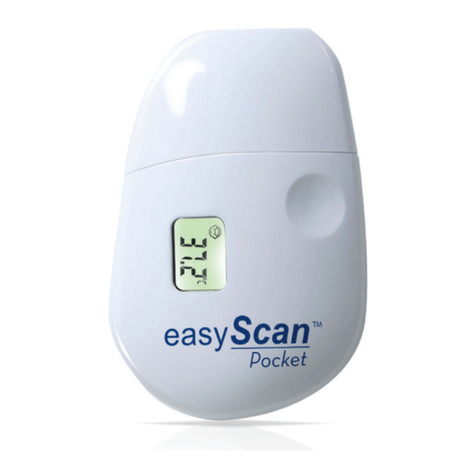
VISIOMED
VISIOMED easyScan VM-ZXP1 User manual
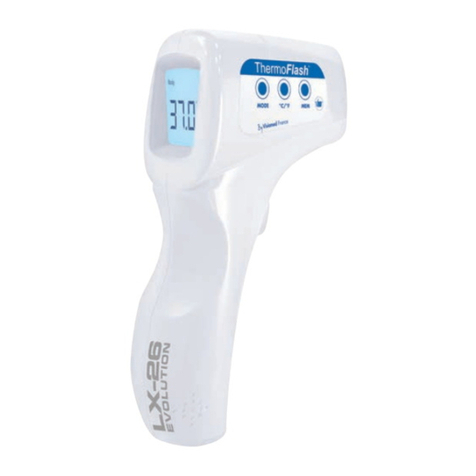
VISIOMED
VISIOMED THERMOFLASH LX-26 User manual

VISIOMED
VISIOMED THERMOFLASH LX-26 User manual

VISIOMED
VISIOMED bewell connect MyThermo Pocket BW-MTX1 User manual

VISIOMED
VISIOMED THERMOFLASH LX-26 User manual
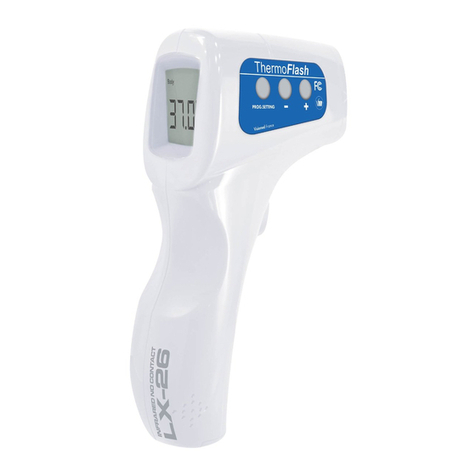
VISIOMED
VISIOMED ThermoFlash LX-26E EVOLUTION User manual
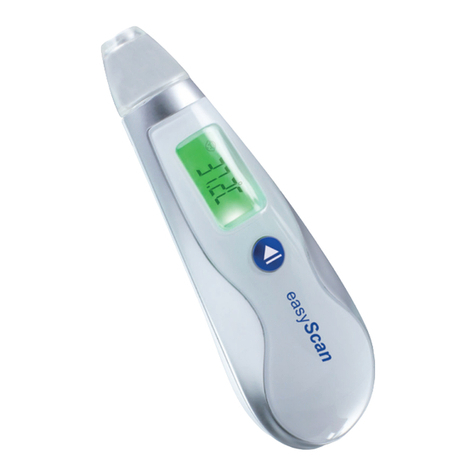
VISIOMED
VISIOMED easyScan VM-ZX1 User manual
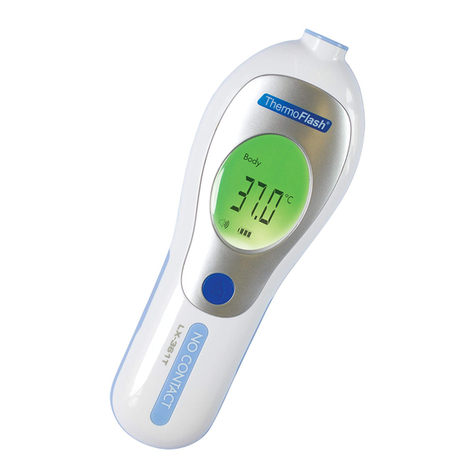
VISIOMED
VISIOMED LX-361T User manual
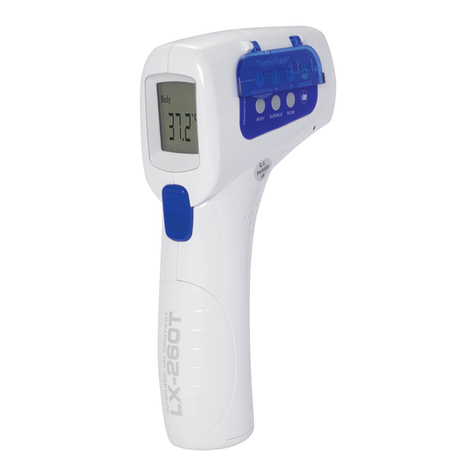
VISIOMED
VISIOMED THERMOFLASH LX-260T EVOLUTION User manual
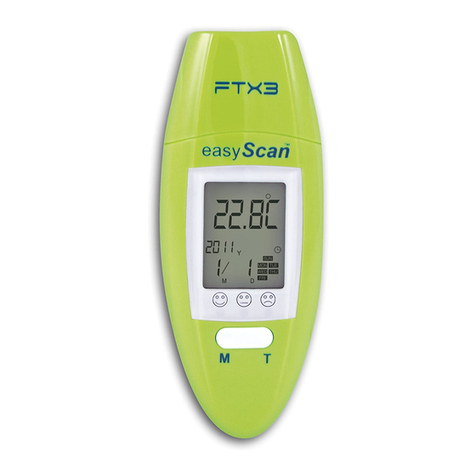
VISIOMED
VISIOMED EASYSCAN FTX3 User manual

